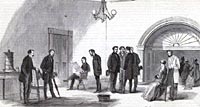The main staircase to the second floor was used by persons seeking to visit the President. Presidential aide William O. Stoddard the days in March 1861 when, “for hours and hours, the anterooms and halls upstairs were so full that they would hold no more, and when the broad staircase itself was also packed and jammed, stair by stair, from top to bottom, so that one could hardly squeeze his way up or down. This was all cut short by one of Lincoln’s decrees. He decided not to interfere with his Cabinet officers in the selection of their clerks and other subordinates. As he expressed it, ‘I have ceased to have any influence with this Administration.'” Stoddard himself struggled with the crowd on the stairs when he came to present his own card; Stoddard has been asked earlier in the year to come to Washington to work for Mr. Lincoln. When John G. Nicolay came to the top of the stairway and called Stoddard’s name, he asked: “Do you wish to see the President?”
No, I don’t,” I shouted. Tell him I’m here ‘cording to orders. That’s all. He’ll know what to do. I won’t bother him now.’
A score or more of the folks on the stairs and behind me laughed, and even Mr. Nicolay seemed pleased with my reply. I think it must have pleased Mr. Lincoln, also, as only a few days later I received notice of my coming appointment as ‘Secretary to the President to Sign Land Patents.’ After that, and even before actually receiving my commission, I was a marked man and worthy of much respect. I came and went to and from the White House, but the stairway was still corked.”1
A sick President Lincoln stood at the top of these stairs on December 16, 1864, holding a candle, when Edwin Stanton and Thomas Eckert reported the Union victory at Nashville. It was on these stairs where John Hay and Robert Todd Lincoln learned of Lincoln’s assassination. The President himself often used a separate, more private staircase to the first floor and to the basement, where he could escape from the White House without public notice. One day, when he did use the grand staircase, he came across Julia Taft sitting and reading a novel. Before she could get up, he said: “Sit still, Julie, I’ll walk right over you.” 2 It was also down these stairs and Mr. and Mrs. Lincoln would promenade on the way to a presidential reception.
“The grand stairway, which occupied the entire end of the west hall, was in the same configuration [architect] Hotban had originally designed and President [James] Monroe had rebuilt after the War of 1812,” wrote White House historian William Seale. “It rose from the lower transverse hall in two broad arms which united on a landing lighted by the mighty glass half-moon window, then proceeded as one broad stair up the center to the second floor. The handrail was mahogany, and the spindles were painted white. Brussels carpeting on the steps was held in place by brass rods. From the head of the stair the winter sunsets were magnificent, seen through the great window.”3
Footnotes
- William O. Stoddard, Jr., editor, Lincoln’s Third Secretary, pp. 70-71.
- Julia Taft Bayne, Tad Lincoln’s Father, p. 162.
- William Seale, The History of the White House, p. 379.








